Ireland offers a wealth of breathtaking landscapes and rich history, and this guide from TRAVELS.EDU.VN details exactly how to experience the best of the Emerald Isle using a variety of transportation options. Whether you’re searching for budget-friendly travel, scenic routes, or the freedom of independent exploration, Ireland’s trains, buses, ferries, and boats ensure a memorable journey, allowing you to discover charming villages, lively cities, and famous landmarks, all while supporting ecotourism and sustainable travel practices.
1. What Are The Best Ways To Travel Around Ireland Without A Car?
Traveling around Ireland without a car is surprisingly convenient thanks to the country’s extensive public transportation system. You can travel between cities using Irish Rail, explore various regions by bus, or discover coastal regions by ferry, all contributing to sustainable tourism by reducing your carbon footprint.
1.1 Using Irish Rail For Inter-City Travel
Irish Rail (Iarnród Éireann) offers reliable and cost-effective train services between major cities. Fares are often discounted for those under 24 or using a Leap Card, providing savings up to 30%, and there are price caps for multiple-leg trips. For instance, a direct train from Dublin to Galway takes about 2.5 hours and costs around €20-€30 with a Leap Card, according to Irish Rail’s official website.
1.2 Exploring Via Bus Éireann’s Extensive Network
Bus Éireann provides an extensive network covering destinations that trains don’t reach. Using the Leap Card, you can easily hop on and off buses without needing to buy new tickets each time. A bus journey from Cork to Killarney takes approximately 1.5 to 2 hours, showcasing beautiful rural areas. Tickets can be purchased online or at bus stations for around €15-€20, depending on the route and time of booking.
1.3 Discovering Coastal Regions By Ferry
Ferries offer access to Ireland’s remote islands, such as the Aran Islands. Although some services may scale back in the winter, year-round options are available. A round-trip ferry from Doolin to the Aran Islands typically costs around €30-€35, with a journey time of 30-45 minutes each way, per Doolin Ferry’s schedule.
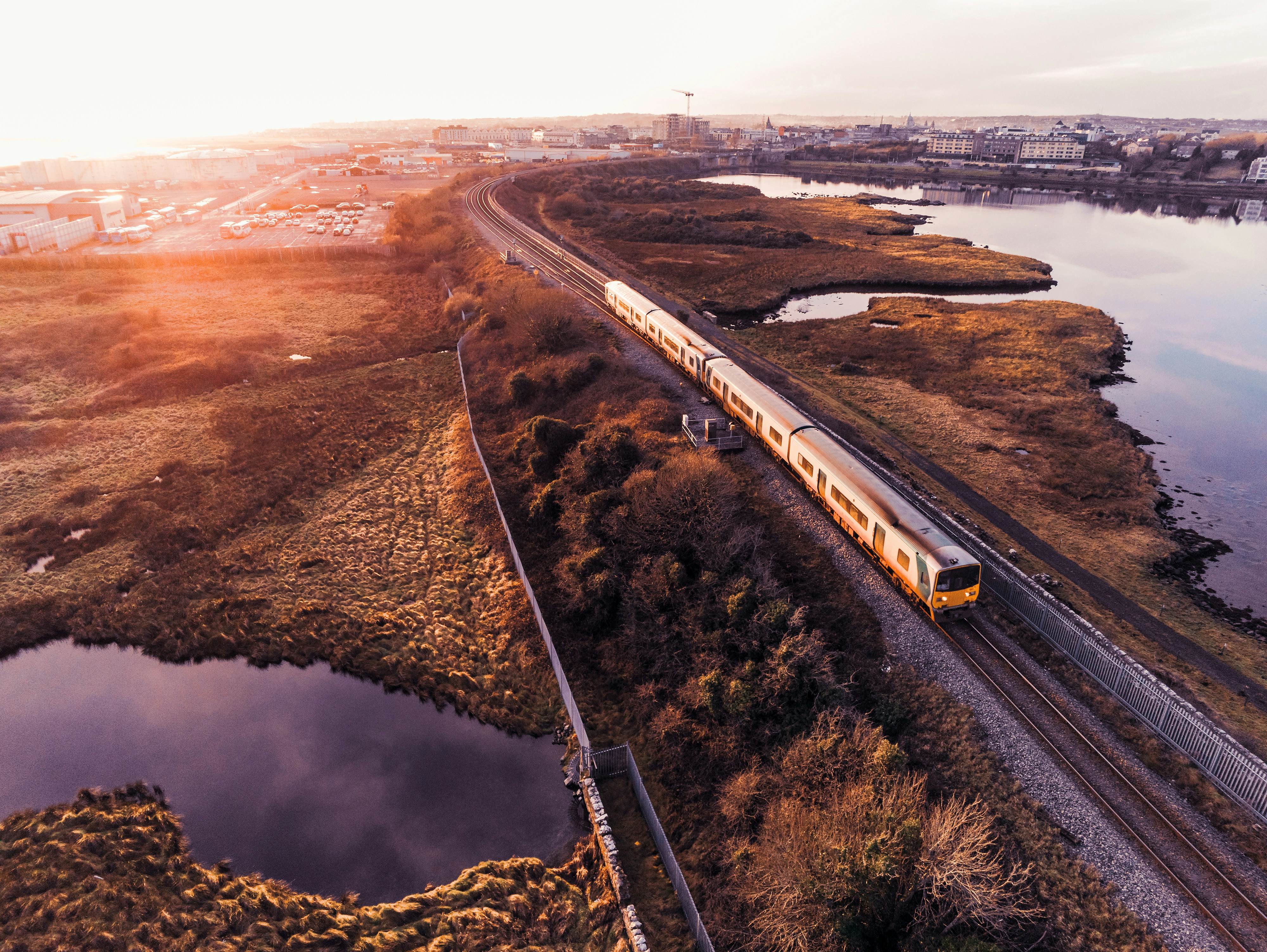 An aerial view of an Irish Rail train at sunset, Galway, Ireland
An aerial view of an Irish Rail train at sunset, Galway, Ireland
Caption: Trains connect major cities in Ireland, providing an alternative to a rental car.
2. What Are The Advantages Of Using A Leap Card For Travel In Ireland?
A Leap Card offers substantial discounts on bus, tram, and train fares across Ireland, making public transportation more affordable and convenient, contributing to the overall sustainability of travel within the country.
2.1 Cost Savings With A Leap Card
The Leap Card provides fare discounts of up to 30% on Irish Rail, Bus Éireann, Dublin Bus, and the Luas (Dublin’s tram service). Additionally, there are daily and weekly caps, ensuring you never pay more than a set amount for unlimited travel within a specified period.
2.2 Convenience And Flexibility
Using a Leap Card means you don’t have to worry about carrying cash or purchasing individual tickets. You can simply tap on and off at each journey, making transfers seamless. This flexibility is particularly useful when exploring rural areas, where you might decide to hop off at an interesting spot and catch the next bus.
2.3 Leap Visitor Card For Tourists
For tourists, the Leap Visitor Card offers unlimited travel within Dublin and surrounding areas for a set period (1, 3, or 7 days). It covers all Dublin Bus services, the Luas, and the DART (Dublin Area Rapid Transit), making it an ideal choice for exploring the city’s attractions and suburbs, per information on Transport for Ireland’s official website.
3. What Are The Most Scenic Train Routes In Ireland?
Ireland boasts several scenic train routes that offer stunning views of the countryside, making the journey as enjoyable as the destination, emphasizing ecotourism by minimizing environmental impact.
3.1 The Dublin To Cork Route
The Dublin to Cork route offers picturesque views of the Irish midlands, passing through lush green fields and charming towns. The journey takes approximately 2.5 to 3 hours, with tickets ranging from €25 to €40 depending on the time of booking.
3.2 The Dublin To Galway Route
Traveling from Dublin to Galway, you’ll witness the rugged beauty of the west coast, including glimpses of the Atlantic Ocean. This route takes around 2.5 hours and provides a comfortable and scenic alternative to driving.
3.3 The Cork To Killarney Route
The train journey from Cork to Killarney is particularly scenic, running through the heart of County Kerry. You’ll be treated to views of mountains, lakes, and forests, making it a truly unforgettable experience. The journey takes about 1.5 hours, with tickets typically costing between €15 and €25.
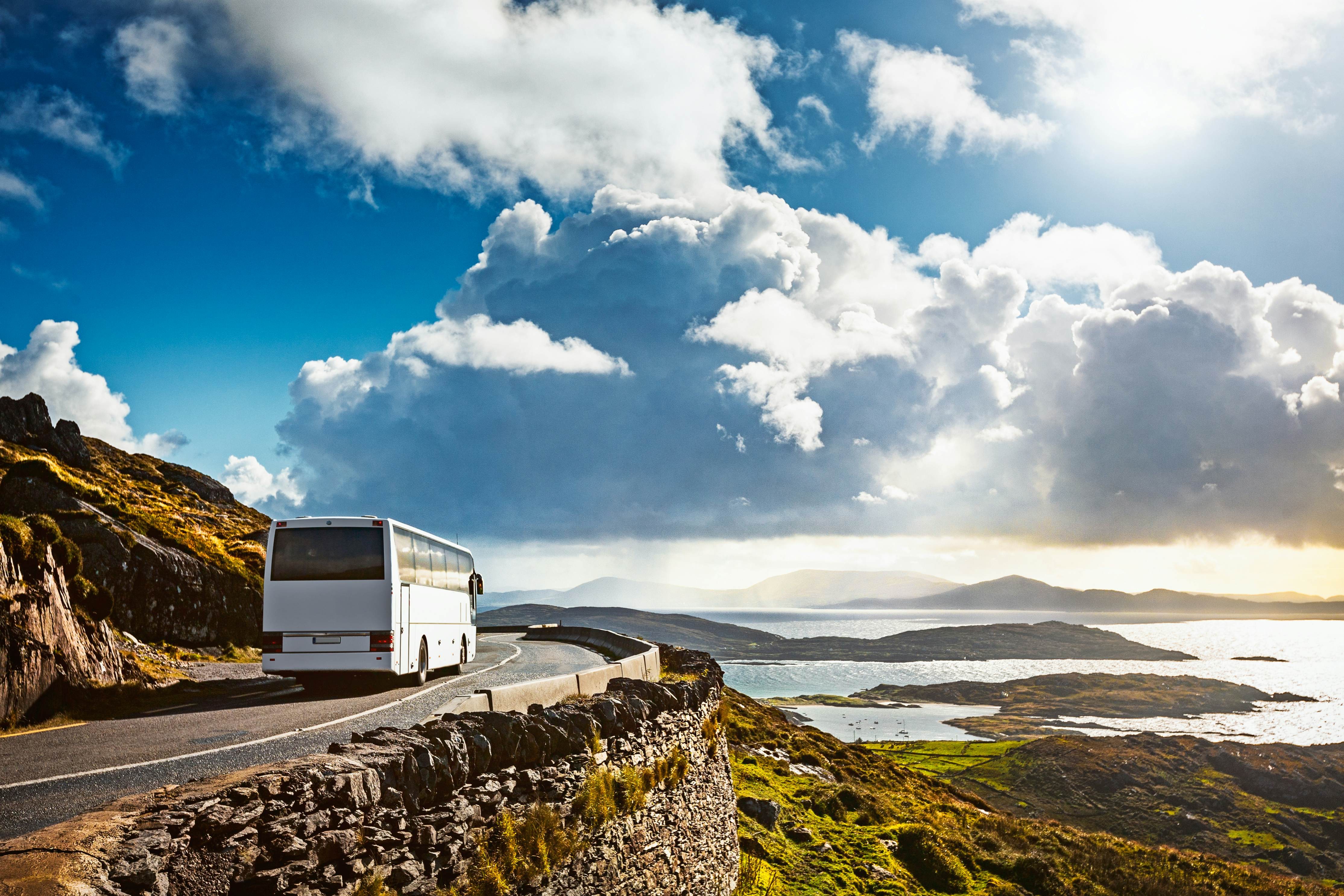 A bus on a mountain road, Ring of Kerry, Ireland
A bus on a mountain road, Ring of Kerry, Ireland
Caption: Taking in spectacular scenery during a long bus ride can be more rewarding than the destination
4. What Are The Best Bus Routes For Exploring Rural Ireland?
Ireland’s bus network is extensive, offering access to some of the most beautiful and remote parts of the country, furthering responsible travel by reaching lesser-known attractions.
4.1 County Clare’s Route 350
County Clare’s Route 350 skims along the Atlantic edge of the Burren National Park and passes by the Cliffs of Moher, providing breathtaking coastal views. The entire route takes approximately 2.5 hours, with tickets costing around €20-€25.
4.2 County Cork’s Route 237
Route 237 in County Cork passes through a chain of pretty seaside towns, offering a glimpse into the region’s maritime charm. This route takes about 2 hours and costs around €15-€20.
4.3 Routes Through Dingle, Ring Of Kerry, Connemara And Beara Peninsula
Similar bus services are available for Dingle, the Ring of Kerry, Connemara, and the Beara Peninsula, each offering unique landscapes and cultural experiences. Timetables should be checked in advance as these routes are less frequent.
5. How Can You Incorporate Cycling And Hiking Into Your Ireland Trip?
Ireland boasts numerous off-road hiking and cycling routes, allowing you to experience the country’s natural beauty up close, furthering ecotourism by promoting active and environmentally friendly exploration.
5.1 Off-Road Cycling Trails
Disused railway lines in Mayo and Limerick have been converted into scenic trails, providing safe and enjoyable cycling routes. These trails offer spectacular backdrops and are suitable for cyclists of all levels.
5.2 Hiking The Beara-Breifne Way
The Beara Peninsula in County Cork marks the trailhead for the longest trek in Ireland, the Beara-Breifne Way. This long-distance trail offers a challenging but rewarding experience for avid hikers.
5.3 Glenveagh National Park
Glenveagh National Park in Donegal provides numerous hiking trails with varying difficulty levels, showcasing the rugged beauty of the Irish highlands.
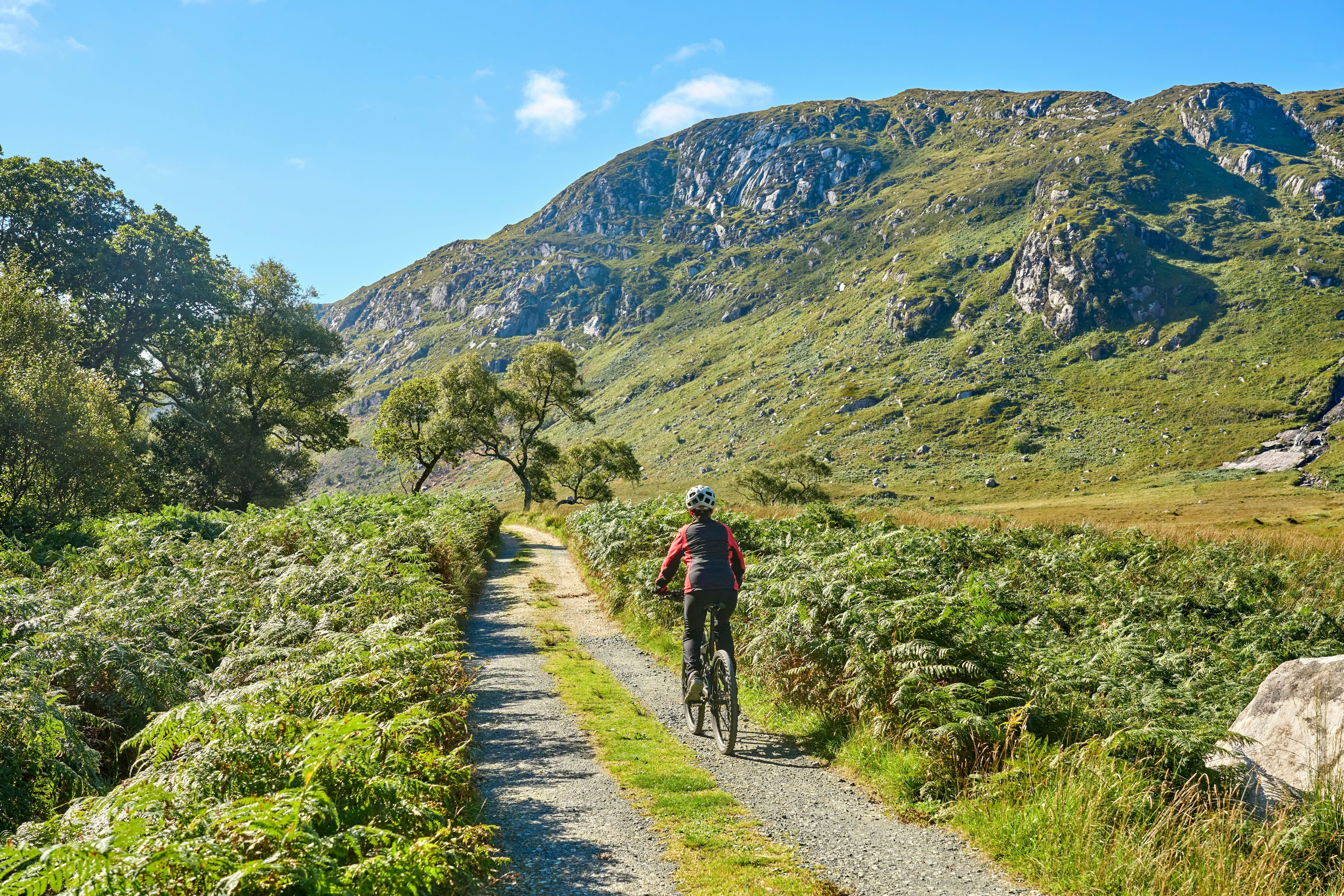 A cyclist in Lough Beagh, Glenveagh National Park, near Churchill, Donegal, Ireland
A cyclist in Lough Beagh, Glenveagh National Park, near Churchill, Donegal, Ireland
Caption: Get off the (paved) grid by tackling one of Ireland’s many off-road-cycling trails
6. What Are The Best Ways To Explore Dublin Without A Car?
Dublin offers excellent public transportation options, including buses, trams, and trains, making it easy to explore the city and its surroundings without a car, promoting sustainable urban tourism.
6.1 Dublin Bus
Dublin Bus operates an extensive network throughout the city and its suburbs. With the Leap Card, you can easily hop on and off buses to reach various attractions.
6.2 The Luas Tram Service
The Luas (meaning “speed” in Irish) is Dublin’s modern tram service. The Green Line runs north to south, while the Red Line runs east to west, both crossing in the city center. The Luas provides a thrifty and efficient way to travel from the city center to its outer reaches.
6.3 The Dart (Dublin Area Rapid Transit)
The DART is a light-rail system that connects Dublin to its seaside suburbs. It’s a great way to explore coastal towns like Howth and Bray, offering scenic views of the Irish Sea.
7. How Can Ferries Enhance Your Irish Travel Experience?
Ferries provide access to Ireland’s remote islands, offering unique cultural experiences and stunning landscapes that are otherwise inaccessible, all while promoting responsible tourism by supporting local island economies.
7.1 Visiting The Aran Islands
A ferry to the Aran Islands is a must-do for many visitors. These islands offer a glimpse into traditional Irish culture, with ancient stone forts and stunning coastal scenery. Ferries operate from Doolin and Galway, with varying schedules depending on the season.
7.2 Crossing The River Shannon
Drivers can take a ferry across the River Shannon to travel directly from County Kerry to County Clare, saving time and offering a unique perspective on the Irish landscape.
7.3 Exploring Other Irish Islands
Numerous other islands around Ireland are accessible by ferry, each offering its own unique charm and attractions. These include the Blasket Islands, Cape Clear Island, and Tory Island.
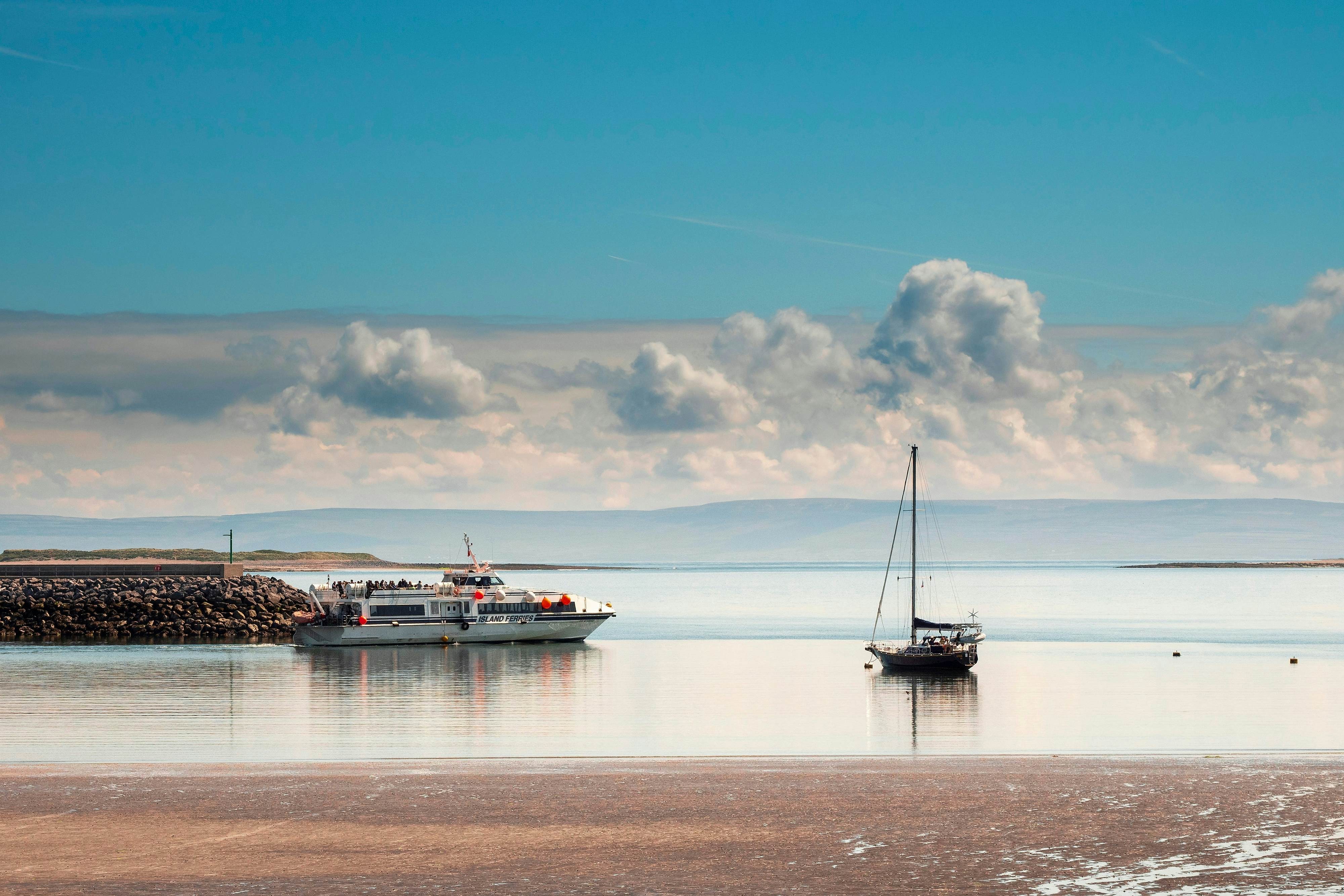 A departing ferry, Inishmore, Aran Islands, Ireland
A departing ferry, Inishmore, Aran Islands, Ireland
Caption: A ferry is the only way to reach the beautiful, remote Aran Islands
8. What Are The Options For Accessible Transportation In Ireland?
Ireland has made significant improvements in accessible transportation, ensuring that individuals with mobility issues can enjoy the country’s attractions, contributing to inclusive tourism practices.
8.1 Accessible Buses And Trains
Transport operators like Dublin Bus, Go-Ahead Ireland, Irish Rail, Bus Éireann, and the Luas provide detailed information about wheelchair access and tailored accessibility on their websites. Many buses and trains are equipped with ramps and designated wheelchair spaces.
8.2 Assistance Services
Irish Rail offers assistance services for passengers with disabilities, including help with boarding and alighting trains. Bus Éireann also provides assistance for passengers with mobility issues, ensuring a comfortable and safe journey.
8.3 Accessible Accommodation And Attractions
Many hotels, guesthouses, and tourist attractions in Ireland have been adapted to accommodate visitors with disabilities, offering accessible rooms, ramps, and other facilities.
9. How To Travel Around Ireland With Children?
Traveling around Ireland with children is made easier with family-friendly transportation options and discounts, supporting family tourism and creating memorable experiences.
9.1 Free Travel For Young Children
Children under 5 accompanied by a Leap Card holder can travel on Bus Éireann (including Expressway), Luas, Irish Rail, and Dublin Bus for free. This makes it more affordable to explore Ireland as a family.
9.2 Space For Prams And Strollers
Space is typically offered for prams and strollers on buses and trains, although priority is given to wheelchair users. It’s advisable to check availability in advance, especially during peak travel times.
9.3 Family-Friendly Attractions
Ireland offers numerous family-friendly attractions, including zoos, parks, and historical sites, providing plenty of opportunities for fun and educational experiences.
10. What Should You Consider When Renting A Car In Ireland?
Renting a car in Ireland offers flexibility, but it’s important to consider costs, road conditions, and insurance coverage to ensure a safe and enjoyable trip.
10.1 Costs Of Car Rental
Car rental costs in Ireland can be high, especially during peak season. In addition to the rental fee, you’ll need to factor in tolls, parking, fuel, and insurance. It’s advisable to book in advance to secure the best rates.
10.2 Road Conditions And Driving Tips
Many of Ireland’s most scenic locations are accessed via narrow country lanes, requiring careful driving. Be prepared for winding roads, limited visibility, and the occasional farm animal. In winter months, roads may have black ice, so caution is advised.
10.3 Insurance Coverage
If you plan to drive through Northern Ireland, check that your car insurance covers the UK before you go. It’s also important to understand the terms and conditions of your rental agreement and ensure you have adequate insurance coverage.
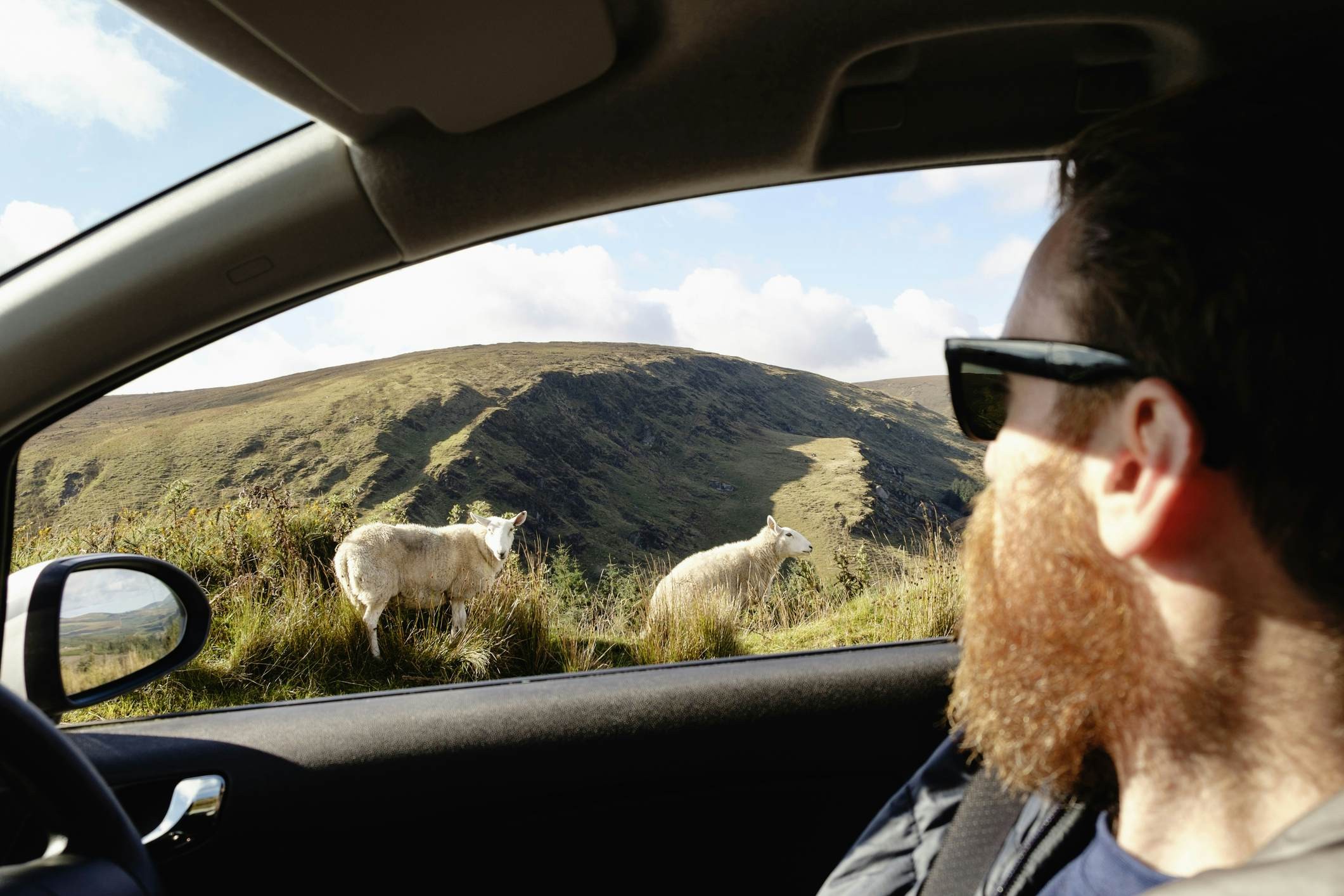 A man looks at sheep through his car window, Ireland
A man looks at sheep through his car window, Ireland
Caption: Renting a car gives you the ultimate freedom – and gets you up close and personal with rural Ireland
11. What Unique Experiences Can You Have On The River Shannon?
Renting a boat on the River Shannon offers a unique way to explore the heart of rural Ireland, providing a tranquil and scenic alternative to traditional transportation.
11.1 Renting A Boat
Visitors can hire a boat on the Shannon from Lough Derg to Lough Erne, or anywhere in between. Along the 362km (225-mile) river, you’ll find plenty of spots to collect or drop off a rented boat.
11.2 Exploring Waterways And Villages
The River Shannon is dotted with charming villages and rich landscapes, offering plenty of opportunities for exploration. You can stop off at various points along the way to visit historical sites, enjoy local cuisine, and immerse yourself in Irish culture.
11.3 Self-Paced Travel
Renting a boat allows you to travel at your own pace, giving you the freedom to explore the River Shannon and its surroundings at your leisure. It’s a perfect option for those who want to escape the crowds and enjoy a more tranquil travel experience.
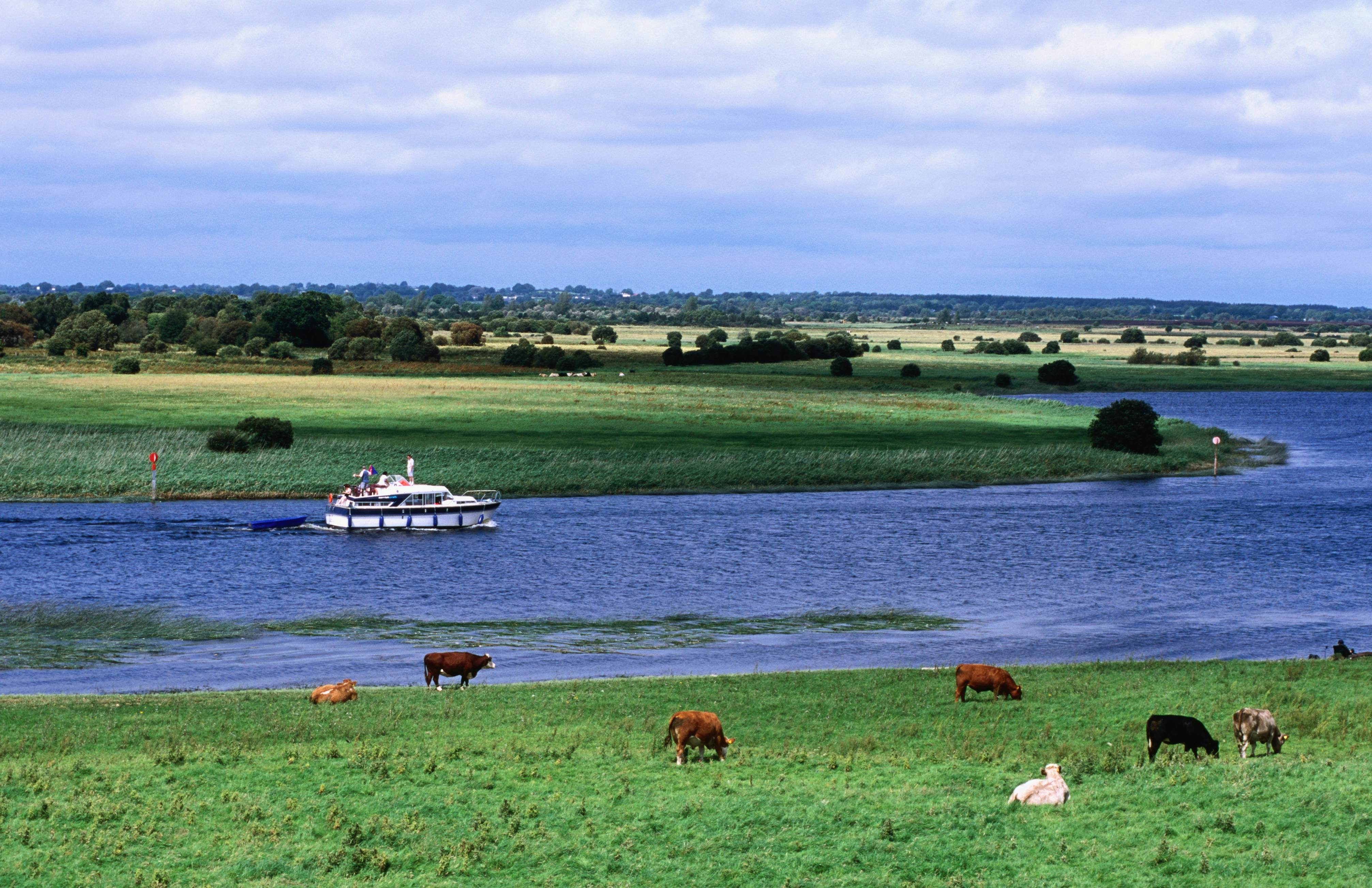 A boat on the River Shannon, Clonmacnoise, County Offaly, Ireland, Europe
A boat on the River Shannon, Clonmacnoise, County Offaly, Ireland, Europe
Caption: Aboard a private boat on the River Shannon, you’ll float through the heart of rural Ireland
12. How Does TRAVELS.EDU.VN Enhance Your Irish Travel Planning?
TRAVELS.EDU.VN provides expert insights, detailed itineraries, and exclusive deals to ensure your trip to Ireland is seamless and unforgettable. Contact us today at 123 Main St, Napa, CA 94559, United States, Whatsapp: +1 (707) 257-5400, or visit our website at TRAVELS.EDU.VN to start planning your dream vacation.
12.1 Personalized Itineraries
TRAVELS.EDU.VN offers personalized itineraries tailored to your interests and preferences. Whether you’re interested in history, culture, nature, or adventure, we can create a customized itinerary that suits your needs.
12.2 Expert Advice
Our team of travel experts has extensive knowledge of Ireland and can provide valuable advice on transportation, accommodation, and attractions. We can help you navigate the complexities of planning a trip and ensure you have a smooth and enjoyable experience.
12.3 Exclusive Deals
TRAVELS.EDU.VN partners with local providers to offer exclusive deals on transportation, accommodation, and activities. By booking with us, you can save money and enjoy added benefits.
FAQ: Traveling Around Ireland
1. What Is The Cheapest Way To Get Around Ireland?
Public transportation, especially using a Leap Card, is the most cost-effective way to travel around Ireland. Discounts on bus and train fares, combined with daily and weekly caps, ensure you never overpay.
2. Is It Easy To Get Around Ireland Without A Car?
Yes, Ireland has an extensive public transportation network, including trains, buses, and ferries, making it easy to explore the country without a car.
3. How Much Does It Cost To Rent A Car In Ireland?
Car rental costs in Ireland vary depending on the season, vehicle type, and rental duration. Expect to pay between €30 and €100 per day, plus additional costs for tolls, parking, fuel, and insurance.
4. Can I Use My Leap Card On All Public Transportation In Ireland?
The Leap Card is valid on most public transportation services in Dublin and surrounding areas, including Dublin Bus, the Luas, and the DART. It is also accepted on Bus Éireann services nationwide.
5. What Is The Best Time Of Year To Visit Ireland?
The best time to visit Ireland is during the shoulder seasons (April-May and September-October), when the weather is mild, and the crowds are smaller.
6. Are There Any Discounts Available For Students Or Seniors On Public Transportation In Ireland?
Yes, Irish Rail offers discounted fares for users under 24. Seniors may also be eligible for discounts on certain routes.
7. How Reliable Is The Public Transportation In Ireland?
Public transportation in Ireland is generally reliable, but delays can occur, especially during peak travel times or due to unforeseen circumstances. It’s always a good idea to check timetables and plan accordingly.
8. Can I Buy A Leap Card Online?
Yes, you can purchase a Leap Card online through the Transport for Ireland website. You can also buy a Leap Visitor Card upon arrival at Dublin Airport.
9. Are There Any Hop-On Hop-Off Bus Tours In Ireland?
Yes, Dublin and Belfast offer year-round hop-on, hop-off (HOHO) city bus tours operated by private companies. Galway and Cork Cities also offer seasonal city HOHO tours.
10. What Is The Best Way To Get From Dublin Airport To The City Center?
The Airlink Express bus and the Dublin Express bus provide direct services from Dublin Airport to the city center. Taxis and rideshares are also available, but they are generally more expensive.
Ready to experience the magic of Ireland? Contact travels.edu.vn today for personalized travel planning and exclusive deals! Our team is ready to assist you in creating the perfect Irish getaway. Don’t wait, your dream vacation is just a call or click away!